Tea
Caddy Index

History of
caddies
Tea and Opium
Request
current list of available tea
caddies.
| |
A late 18th century rolled paper tea caddy with colored
prints of classical inspiration
Please click on images to enlarge
Reference: TC 110.
Description:
A late 18th century
rolled paper tea caddy the framed panels of filigree spaced
ornament on a background of mica flakes and having colored prints of
classical inspiration under glass. The caddy is framed with fruitwood
inlaid with a chevron of dark and light wood.
Origin: United
Kingdom.
Circa: 1800.
Materials: Rolled
paper decorating on a pine ground with fruitwood.
Size: It measures 6.7 inches
wide by 3.7inches deep and it is inches 6 high:
170cm wide by 96cm deep by 130cm high.
Condition: good
over all, no restorations.
|
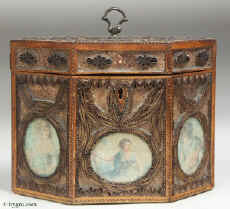
This caddy is featured at figure 118 of our book
Antique Boxes, Tea Caddies, and Society, 1700--1880
Antigone Clarke & Joseph O'Kelly, ISBN: 0764316885
see also: Rolled Paper Tea Caddy
|
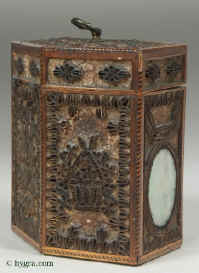
|
Filigree
work was seen as a particular accomplishment for young
ladies of the early 19th c and was was also taught at art school art
classes. Trade cards of the period mention the supply of cases for
filigree work to boarding schools.
In
1791, a royal tradesman, Charles Elliott, supplied Princess Elizabeth,
with "15 ounces of different filigree paper, one ounce of gold
paper, and a box made for filigree work with ebony moldings, lock and
key, lined inside and outside and also a tea cadde to correspond with
box".
|
Please click on images to enlarge
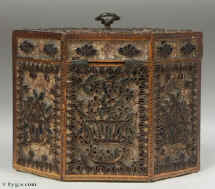
|
Filigree
boxes were also offered for sale by professionals. A correspondent
in the New Ladies' Magazine recommended a Londonshop, in
fashionable Mount Street, where such work was on display. Very likely
the work was done by talented genteel ladies, who had fallen on hard
times. In the 1793 Cabinet Makers' London Book of Prices, the
price of the work is described as follows: "if any of these caddies
are made for fillagree to be the same (price) as veneer'd".
|
In
Sense and Sensibility Jane Austen refers to rolled paper work
work: Elinor offers to help Lucy Steel to roll papers for
decorating a basket Lucy is making for the daughter of their hostess.
Although the novel was started in the last years of the 18th century, it
was not published until 1811. It is of course impossible to know when
the author composed this particular scene.
A
few filigree caddies were also made by Napoleonic prisoners of war.
These are indistinguishable from English work. There are records and surviving
examples of the work created by the prisoners of war who were more
famous for their straw work and bone work at Norman Cross. See: www.normancrossgallery.com
/history/index.html
|
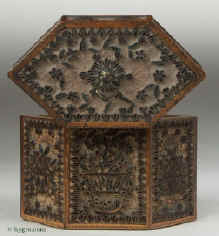
|
Please click on images to enlarge
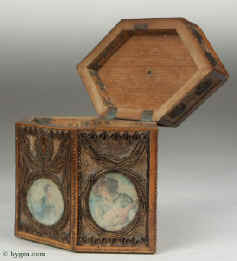
|
The caddy is on a pine body. The grain pattern of the top, with the parallel
lines formed by winter and summer growth, indicates that the
wood is cut on the quarter. Quartered wood is particularly stable.
|
Please click on images to enlarge
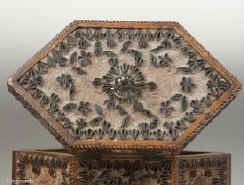
|
The colors of the rolled
papers have by now faded and the gilding on the gold rubbed off.
Expecting to find "pristine" examples is unrealistic.
The often practiced
replacement and re-gilding of the papers frequently results in garish
and artificially glossy creations, which are neither original, nor
honest reproductions.
This caddy has survived
without the indignity of such restorations.
The Dutch drop handle still
retains some of its original gilding.
|
Please click on images to enlarge
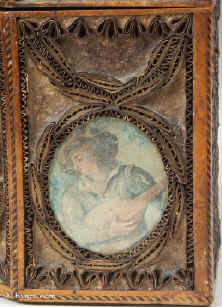
|
Detail: A hand colored
print of cittern player. The cittern was popular from the 17th C.
At the date of the caddy it the instrument was called "an English
guitar". It was a popular an instrument especially for lady amateur
players.
In his book The
World of Baroque & Classical Musical instruments,
Jeremy Montagu recounts a story that it became so popular that it
was seen as a threat to harpsichord manufacture:
"Too many people were selling their harpsichords and buying English
guitars instead... Kirkman [ a well known harpsichord manufacturer] hit
upon the solution --- he gave away a quantity of English Guitars to
seamstresses, ladies who combined their skill at sewing with a rather
older profession, with the result that respectable ladies of fashion immediately
discarded their guitars and returned to the the harpsichord."
|
Please click on images to enlarge
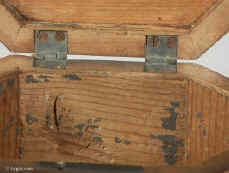
|
There are traces of the original leading on the pine body work of the caddy.
The hinges look undisturbed since the day the caddy was made.
|
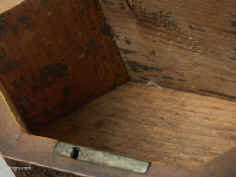
|
The caddy retains its original lock.
|
All text and images and linked images are ©
1999-2006 Antigone Clarke and Joseph O'Kelly. If you require any further
information on permitted use, or a licence to republish any material, email us
at copyright@hygra.com
|
